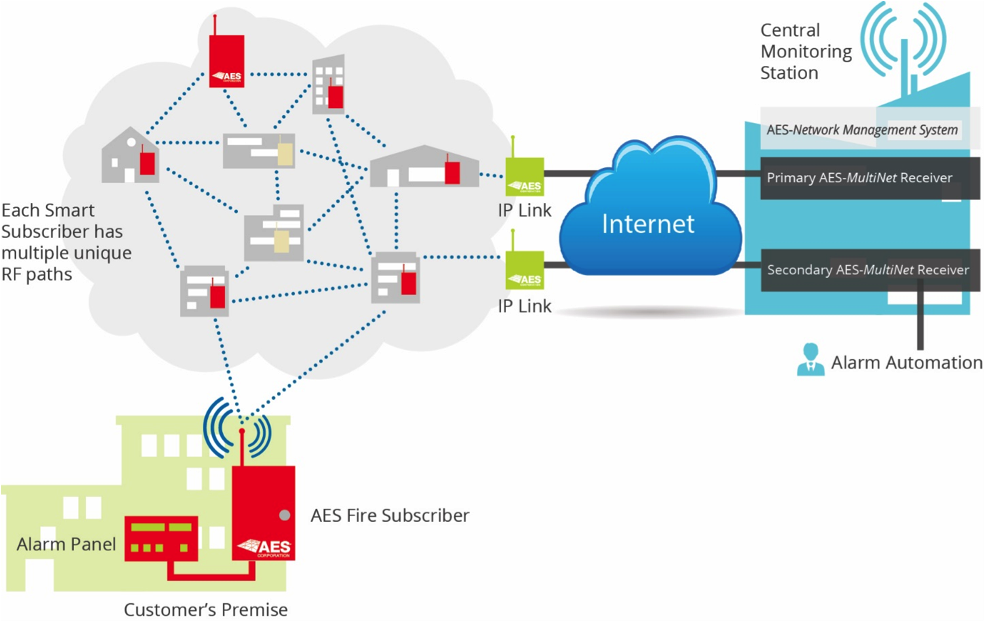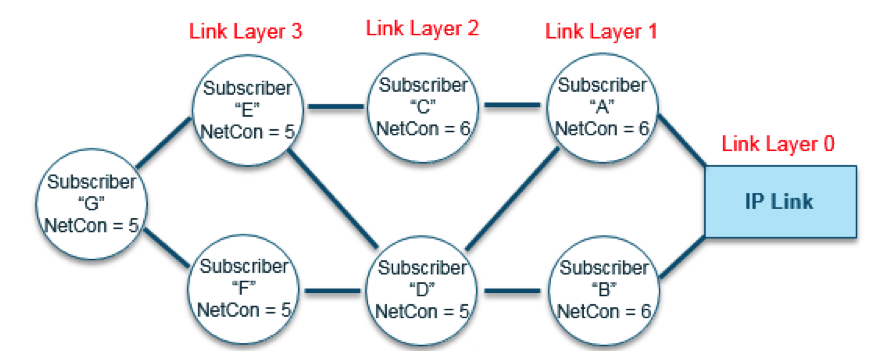Introduction
In order to successfully assess a potential installation site, it is important to understand the basic infrastructural components of an AES-IntelliNet® private wireless mesh radio network. Please become familiar with the terms listed below in advance of performing a site survey.

Mesh Network
Mesh networks built using patented AES-IntelliNet technology consist of many Subscriber units installed in concentric rings around an IP Link which is a major component. The network also contains at least one pair of AES-MultiNet Receivers that allow alarm dealers to operate multiple radio networks.

AES-IntelliNet® Private Wireless Mesh Network
The MAXIMUM distance of Subscribers to each other should be between 2 to 3 miles. Alarm signals transmitted from Subscriber ‘A’ will be repeated and acknowledged by other Subscribers within its routing table. The signals will travel through the mesh network via the shortest path available to an IP Link. The IP Link receives and acknowledges the alarm signal. Generally, 2 IP Links are installed together. The signal is then forwarded via an IP connection to an AES-MultiNet Receiver. AES-MultiNet Receivers are set in pairs, a primary and a secondary (or back-up Receiver). IP Links installed in pairs are NOT primary and secondary, instead they are redundant and operational RF Receivers sharing the Subscriber load. If one IP Link fails, the other will accept and forward messages originally intended for the original IP Link.
NetCon
NetCon is an abbreviation of Network Connectivity. It is a rating of the number of Radio Frequency (RF) paths from a Subscriber to other Subscribers installed in the mesh network. The mesh refers to all the Subscriber units on a network of the same frequency and cipher code. NFPA code REQUIRES a fire Subscriber (AES 7788F) to have 2 paths of communication on the network.
NetCon for Subscriber units manufactured prior to 2009 UL 864 Edition 9 changes indicate NetCon values from 0 to 7. NetCon for Subscriber units manufactured after 2009 UL 864 Edition 9 indicate NetCon values from 5 to 7 on the AES 7245 Network Connectivity Tool (NCT).
A value of NetCon 5 indicates AT LEAST 2 GOOD paths to the network. There could be more paths, but the value of NetCon 5 indicates 2 good paths. For pre-edition 9 Subscriber units, a NetCon value of 5 IS 2 good paths to the network; NetCon of 4 indicates 3 good paths; NetCon 3 indicates 4 good paths, etc.
Subscriber vs. Radio
The 7788F and 7058E are fire and burglary Subscribers. The silver box mounted on the left side of the cabinet of the Subscriber unit is the transceiver. It’s about the size of a deck of playing cards. This transceiver is the radio component, it transmits and receives the RF messages exchanged between Subscribers. Subscribers are routinely referred to as radios, but remember the radio is technically the transceiver.
Network Connectivity Tool (NCT)
The AES 7245 NCT is a tool engineered to facilitate testing RF performance using NetCon readings by way of a mobile solution. The NCT is a light weight, self-contained, portable unit designed to quickly relay NetCon readings and validate installation locations.
Cipher Code
This is a unique code used by all Subscribers and IP Links on a network. The cipher code is similar to a password or key for a network. This protects communications that take place over your network. Each Subscriber must be programmed with a Unit ID (account number) AND a valid cipher code to talk on the network. The cipher code cannot be viewed from the Handheld Programmer (AES 7041E), it will always show as X’s. This is to prevent another company from accessing your Subscriber and protect your cipher code.
Routing Table
A routing table exists for each Subscriber on a network. It can contain up to 8 viable transmission routes. The routing tables are only visible via a Handheld Programmer or through IP Control. Routes, also known as paths, are what Subscribers will depend on to deliver alarm signals back to the Central Monitoring Station. This table is dynamic, meaning that as conditions change (i.e., other Subscribers have troubles or are removed from the network) the table changes and other Subscribers are entered into the list. The best route is always first on the list.
A good route consists of the following elements:
- The dependent Subscriber is at the same Link Layer or Lower than the current Subscriber.
- The NetCon is 5 or 6.
- The Q level is 02 or 03. The Q level is the RF signal quality between our Subscriber and the one in the list.
Link Layer
The Link Layer defines how many hops a Subscriber will take to reach an IP Link. A Link Layer of 2 indicates that there is 1 Subscriber between the Subscriber the reading is being taken from and the IP Link.

Performing a Site Survey
When you arrive at a customer site, turn on the NCT before going inside and take note of the NetCon reading to evaluate viability. If it’s a NetCon 5, all is good. Turn the NCT off. If you cannot attain a NetCon 5 outside in free air at the site you are visiting, you may need to test using a larger antenna. If a NetCon 5 is not available outside the facility, the signal is NOT going to get better inside the building. There are areas where RF communication is spotty or non-existent due to terrain, foliage, or other environmental issues. If you get a NetCon value of 5 outside, move on to testing at the Fire Alarm Control Panel (FACP).
When you get to the area or mechanical room where the FACP is located, put the NCT directly in the location you intend for the Subscriber to be mounted. Remember, the rubber duck antenna needs to be at a minimum of 18” away from ANY metal or steel such as conduits, metal ducting, T-Bar ceiling grid, or steel studs (which will not be visible).
Turn the NCT back on to get a NetCon reading directly from that mounting area. It can take up to 5 minutes for a final NetCon reading. If you cannot get a NetCon 5 from that location, look around the room for an alternate mounting location. Look for an area clear of metal, PREFERABLY ON AN OUTSIDE WALL. If you are in a basement, or otherwise below grade, you most likely will have issues trying to get a NetCon 5. Turn the NCT off, move the NCT to the alternate location and turn it back on.
If you cannot get a NetCon 5 in the room the FACP is located in, you have some options. The Subscriber can be mounted away from the FACP. As long as you are NOT using a 7788F-ULP-P or a 7795 kit (where the only connection to the FACP is dialer tip and ring), there are no restrictions on where the Subscriber can be mounted. It could be in another mechanical room on a higher floor or a room with an outside wall. IF you are using a 7788F-ULP-P or 7795 kit, there ARE restrictions on how far the Subscriber can be from the FACP. In the same room OR within 20 feet of the FACP. All connections between the FACP and the Subscriber are required to be in conduit.
If you can’t find a suitable location for the Subscriber that can attain a NetCon 5, your next option is mounting an outdoor antenna. Antennas need to be mounted outside, at 18” minimum above the highest point on the roof and 18” minimum away from any metal or steel. Cabling is required to be in conduit and a lightning protector MUST be used. Antenna cable is a special low loss RF cable with a solid center conductor. For shorter lengths, use RG-58 and for longer distances, RG-8 or LMR-400 might be required. The maximum distance for RG-58 cable is 25’ from the subscriber to the antenna, including the lightning protector. The maximum distance on RG-8 is 75’. LMR-400 can be used up to 125’ and will need the specific terminations for that cable. Pre-terminated spools are available for purchase through AES in the following lengths: 10, 15, 20 and 25 feet (RG-58 is not in spools). 100’ spools of RG-8 with one end pre-terminated are also available as are RG-8 spools pre-terminated in 6, 25 and 50’ lengths. The Belden equivalent for RG-8 is 9913.
Performing this Site Survey is critical for you to properly quote or estimate the cost of the AES installation. Not knowing the NetCon readings outside and inside will make your quote marginal. If you cannot attain a NetCon 5 outside, further testing with a high gain antenna outside by your technicians will be necessary prior to quoting the site for AES mesh network Subscribers. When in doubt, always seek professional advice. Our Support team of alarm industry experts are available Monday through Friday from 8am to 8pm EST and 24/7 for emergency IP Link and AES-MultiNet Receiver down situations.
aes-corp.com | dealer login | (866) 237-3693 | support@aes-corp.com

